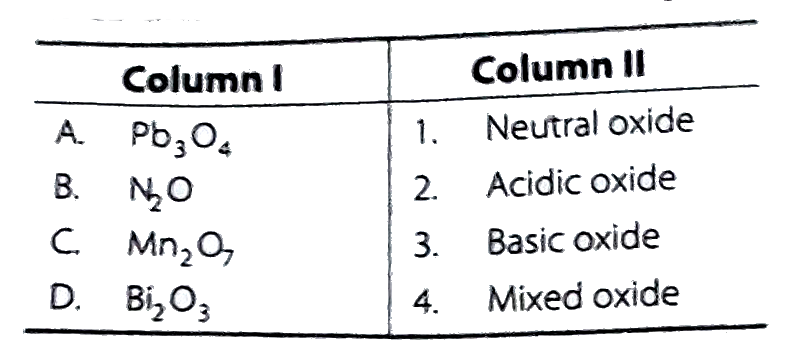Column AColumn Ba.Na2Oi. Amphoteric oxideb.Cl2O7ii. Acidic oxidec.Al2O3iii. Neutral oxided.COiv. Basix oxide
The correct Answer is:a.(iv), b.(ii), c.(i), d.(iii)
To solve the problem of matching the compounds in Column A with their corresponding types in Column B, we will analyze each compound based on its chemical properties.
1. Identify Na₂O:
- Sodium oxide (Na₂O) is formed from sodium, which is a metal.
- Metal oxides are generally basic in nature.
- Conclusion: Na₂O is a basic oxide.
- Match: (a) Na₂O → (iv) Basic oxide.
2. Identify Cl₂O₇:
- Dichlorine heptoxide (Cl₂O₇) is formed from chlorine, which is a non-metal.
- Non-metal oxides are typically acidic.
- Conclusion: Cl₂O₇ is an acidic oxide.
- Match: (b) Cl₂O₇ → (ii) Acidic oxide.
3. Identify Al₂O₃:
- Aluminum oxide (Al₂O₃) has properties of both acids and bases.
- It can react with acids to form salts and with bases to form complex ions, indicating that it is amphoteric.
- Conclusion: Al₂O₃ is an amphoteric oxide.
- Match: (c) Al₂O₃ → (i) Amphoteric oxide.
4. Identify CO:
- Carbon monoxide (CO) does not exhibit acidic or basic properties; it is neutral.
- It does not react with acids or bases in a way that would classify it as either.
- Conclusion: CO is a neutral oxide.
- Match: (d) CO → (iii) Neutral oxide.
Final Matches:
- (a) Na₂O → (iv) Basic oxide
- (b) Cl₂O₇ → (ii) Acidic oxide
- (c) Al₂O₃ → (i) Amphoteric oxide
- (d) CO → (iii) Neutral oxide
Summary of Matches:
- A: Na₂O → iv: Basic oxide
- B: Cl₂O₇ → ii: Acidic oxide
- C: Al₂O₃ → i: Amphoteric oxide
- D: CO → iii: Neutral oxide
---
- Sodium oxide (Na₂O) is formed from sodium, which is a metal.
- Metal oxides are generally basic in nature.
- Conclusion: Na₂O is a basic oxide.
- Match: (a) Na₂O → (iv) Basic oxide.
- Dichlorine heptoxide (Cl₂O₇) is formed from chlorine, which is a non-metal.
- Non-metal oxides are typically acidic.
- Conclusion: Cl₂O₇ is an acidic oxide.
- Match: (b) Cl₂O₇ → (ii) Acidic oxide.
- Aluminum oxide (Al₂O₃) has properties of both acids and bases.
- It can react with acids to form salts and with bases to form complex ions, indicating that it is amphoteric.
- Conclusion: Al₂O₃ is an amphoteric oxide.
- Match: (c) Al₂O₃ → (i) Amphoteric oxide.
- Carbon monoxide (CO) does not exhibit acidic or basic properties; it is neutral.
- It does not react with acids or bases in a way that would classify it as either.
- Conclusion: CO is a neutral oxide.
- Match: (d) CO → (iii) Neutral oxide.
- (a) Na₂O → (iv) Basic oxide
- (b) Cl₂O₇ → (ii) Acidic oxide
- (c) Al₂O₃ → (i) Amphoteric oxide
- (d) CO → (iii) Neutral oxide
- A: Na₂O → iv: Basic oxide
- B: Cl₂O₇ → ii: Acidic oxide
- C: Al₂O₃ → i: Amphoteric oxide
- D: CO → iii: Neutral oxide
Topper's Solved these Questions
- CLASSIFICATION OF ELEMENTS AND PERIODICITY IN PROPERTIES BOOK - CBSE COMPLEMENTARY MATERIALCHAPTER - CLASSIFICATION OF ELEMENTS AND PERIODICITY IN PROPERTIES EXERCISE - ASSERTION AND REASON TYPE QUESTIONS
4 Videos
- CLASSIFICATION OF ELEMENTS AND PERIODICITY IN PROPERTIES BOOK - CBSE COMPLEMENTARY MATERIALCHAPTER - CLASSIFICATION OF ELEMENTS AND PERIODICITY IN PROPERTIES EXERCISE - ONE WORD ANSWER TYPE QUESTIONS
11 Videos
- CLASSIFICATION OF ELEMENTS AND PERIODICITY IN PROPERTIES BOOK - CBSE COMPLEMENTARY MATERIALCHAPTER - CLASSIFICATION OF ELEMENTS AND PERIODICITY IN PROPERTIES EXERCISE - TRUE AND FALSE TYPE QUESTIONS
10 Videos
- CHEMICAL THERMODYNAMICSBOOK - CBSE COMPLEMENTARY MATERIALCHAPTER - CHEMICAL THERMODYNAMICSEXERCISE - Hots Questions
3 Videos
- ENVIRONMENTAL CHEMISTRYBOOK - CBSE COMPLEMENTARY MATERIALCHAPTER - ENVIRONMENTAL CHEMISTRYEXERCISE - UNIT TEST
9 Videos
Similar Questions
Knowledge Check
Match the following regarding nature of the oxides
Column-I Column- IIa.H2O(i)Basicb.Na2O(ii)AmphotericC.ZnO(iii) Acidicd.SO3(iv) NeutralAa(ii) , b(i) , c(ii) , d(iv)Ba(iv) , b(i) , c(ii) , d(ii)Ca(iv) , b(i) , c(ii) , d(iii)Da(ii) , b(i) , c(iv) d(iii)Match the following regarding nature of the oxides
Column-IColumnIIa.N2O(i)Basicb.BaO(ii)Amphotericc.As2O3(iii)Acidicd.CI2O7(iv)NeutralAa (ii) , b(i) , c(iii) , d(iv)Ba(iv) , b(i) , c(iii) , d(ii)Ca(iv) , b(i) , c(ii) , d(iii)Da(ii) , b(i) , c(iv), d(iii)Match the formulas of oxides given in Column I with the type of oxide given in Column II and mark the correct option.
 AA(1)B(2)C(3)D(4)BA(4)B(1)C(2)D(3)CA(3)B(2)C(4)D(1)DA(4)B(3)C(1)D(2)
AA(1)B(2)C(3)D(4)BA(4)B(1)C(2)D(3)CA(3)B(2)C(4)D(1)DA(4)B(3)C(1)D(2)
Mn2O3 is acidic/basic oxide.
View SolutionMn2O7 is an acidic oxide, why ?
View SolutionWhy is Al2O3 amphoteric oxide?
View SolutionGallium oxide (Ga2O3) is an amphoteric oxide.
View SolutionMatch the column -
ColumnIColumnII(a)N2O(P)Normal Oxide(b)Na2O(Q)Neutral Oxide(c)Ga2O3(R)Sub Oxide(d)C3O2(S)Basic Oxide(e)V3O4(T)Amphoteric Oxide(U)Mixed Oxide
View Solution
